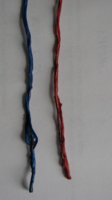On my horns I can't say just what the brand is. They were on the Honda when I bought it.
Harbor Freight has a dual horn set up that sounds a lot like a diesel locomotive horn. About $10. Look a lot like the set on my 75.
On an electric starter you need a starter relay or solenoid. Both the same thing just different names. The starter draws a lot of current. At least 75 amps. You need a starter relay or solenoid that can handle that much current. The stock one works well.
Leo
Harbor Freight has a dual horn set up that sounds a lot like a diesel locomotive horn. About $10. Look a lot like the set on my 75.
On an electric starter you need a starter relay or solenoid. Both the same thing just different names. The starter draws a lot of current. At least 75 amps. You need a starter relay or solenoid that can handle that much current. The stock one works well.
Leo

 Maybe he ran with the high beam on all the time, but that would only be about 5.2 amps. Maybe he installed a monster headlight with 80 or 90 watts? If the bulb shorted out internally, it should have blown the 10 amp headlight fuse, before it melted the insulation. This is why I recommend #16 gauge wire for the headlight circuit, as compared to the stock #18.
Maybe he ran with the high beam on all the time, but that would only be about 5.2 amps. Maybe he installed a monster headlight with 80 or 90 watts? If the bulb shorted out internally, it should have blown the 10 amp headlight fuse, before it melted the insulation. This is why I recommend #16 gauge wire for the headlight circuit, as compared to the stock #18.



